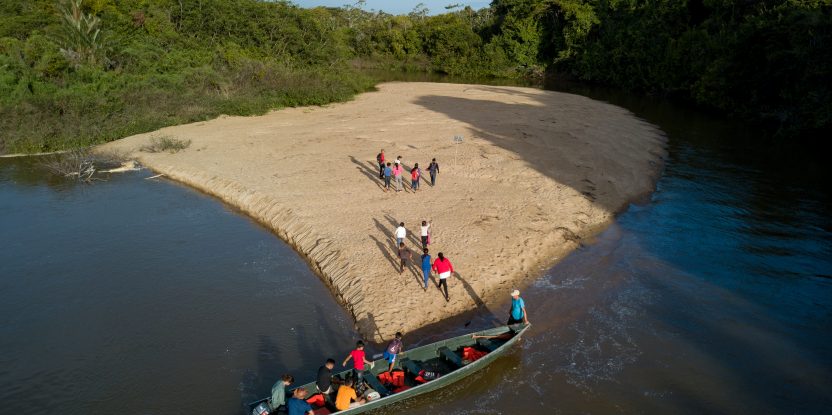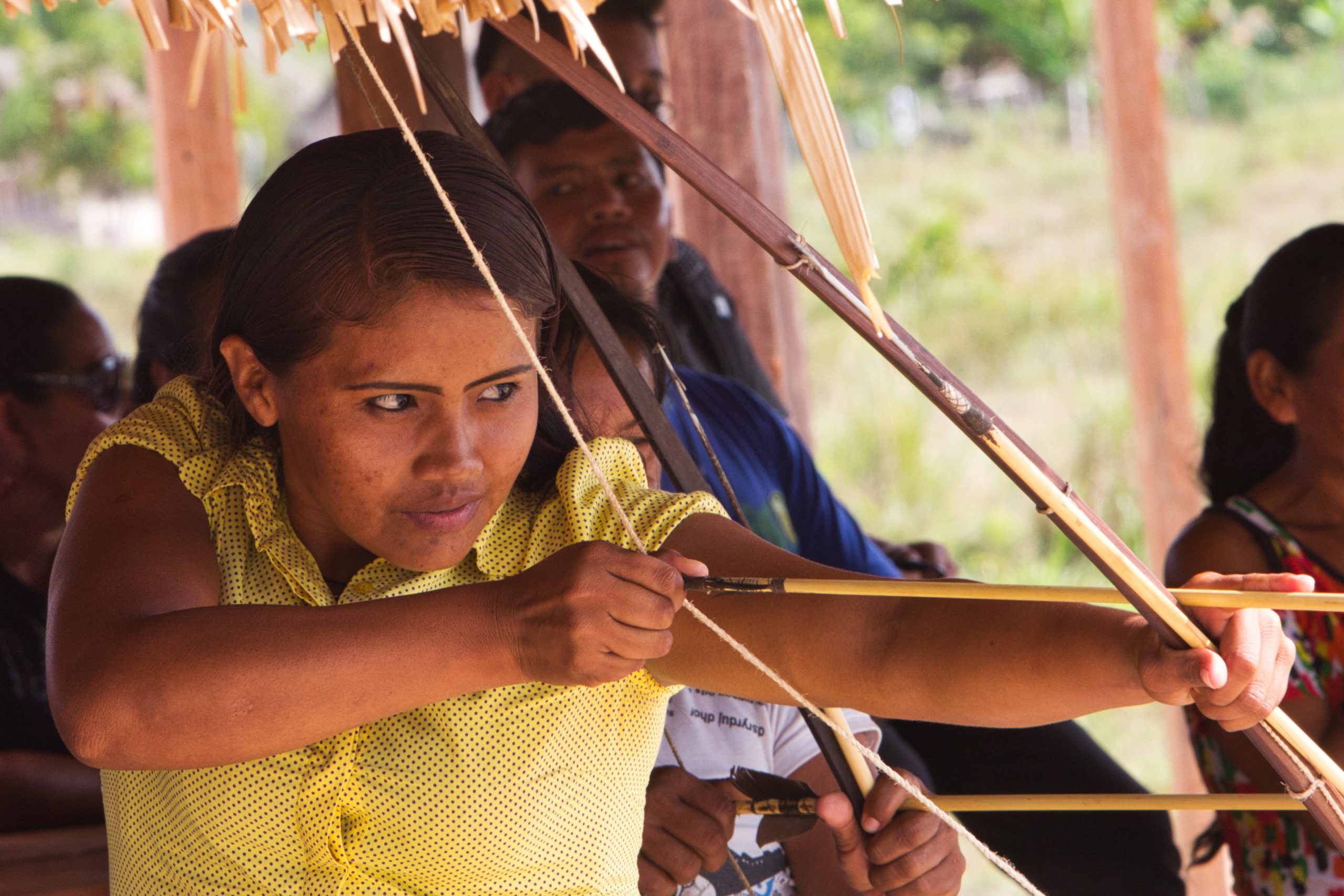
Waking at 3 am to monitor the beaches and paddling with her husband for water lilies and duckweed – favourite foods of the the yellow-spotted river turtle (Podocnemis unifilis) – are some of the responsibilities that Lorrie Ann Thomas has gladly taken on over the past three years.
Growing up in the village of Yupukari in the North Rupununi of Guyana, the 34-year-old Macushi woman never thought she would end up in the field of conservation. Yet today Thomas is a dedicated turtle caretaker and monitor, happily shouldering new responsibilities as they arise.
Twelve years ago, Yupukari began a turtle conservation project with support from various non-governmental organizations. Funding for salaries eventually dried up, but residents like Thomas and her husband Marcellus have sustained this initiative through volunteer work.
In 2019, with support from the Sustainable Wildlife Management (SWM) Programme, the village was once again able to pay community members for this work and began to upscale its river turtle conservation efforts by increasing hatching facilities and monitoring. Thanks to this support, Thomas is now able to earn an income for her conservation efforts.
“We love to eat turtles – both the meat and the eggs – especially around Christmas,” explained Thomas, laughing slightly. “But it was getting harder to find them because their populations were dropping. When the SWM conservation project started, we knew it would be good for our village.” Since becoming so involved in the turtle project, she rarely consumes turtles any more.
The SWM Programme aims to put people’s rights at the centre of wildlife management, seeking an optimal balance between conservation needs and the use of wildlife for food security. Communities on the ground inform strategies and activities to achieve conservation goals, with technical support from SWM.
The programme has also developed and integrated social safeguard strategies, such as gender mainstreaming, to ensure all rights holders, especially women and youth, are involved in its community engagement. One aspect of this strategy is to remove the barriers that have limited the ability of women to participate in and lead sustainable wildlife management activities. The programme ensures a place for women at the decision-making table and employs women like Thomas so that they can take the lead in protecting the natural resources in their communities.
To date, the SWM Programme has employed a total of 131 people in the Rupununi, of which 47% are women and 53% are men. Yupukari Village has ensured a 50/50 balance of men and women in all employment for SWM activities, including monitoring and field research.
Thomas’s favourite activity is processing the monitoring data. “You never know what you will see in the camera trap footage,” she said. “It’s always so exciting!” A dedicated mother, she believes it is important for her children to understand and appreciate the job she is doing.
She has had to bring her three-year-old boy with her on river trips – once for as long as two weeks – since he is too young to leave with family. She said it wasn’t difficult because her son loves fishing, and her husband was also a member of the team, so they took turns caring for the baby.
“Everything I do is for my children,” she said. “While I may not have educational qualifications, I can write and I have other skills and potential. … I am eager to learn, and from all the workshops and capacity building provided, I keep improving.”
When women fully participate in trainings, they develop the skills and knowledge needed to improve their representation within the community. The SWM Programme in Guyana has significantly increased the number of women engaging in all capacity building activities. In the first year, 30% of all participants were women. By the fourth year, this increased to 50% of participants involved in environmental education, camera trapping and research, wildlife monitoring, data collection, and livelihood activities such as poultry farming and ecotourism.
Thomas loves her job and truly enjoys caring for the turtles. Her mission is to involve schoolchildren more, as she recognizes the importance of teaching children natural resource management and conservation from an early age. Thomas and her monitoring team recently invited a group of 15 young wildlife club members on one of their monitoring missions, during which they had to rescue eggs when the beaches began to flood due to rising waters. Wildlife clubs and activities like this help to instil conservation values in the next generation, while also fostering their personal and social development, as children develop environmental stewardship skills – all while having fun.
When asked how she felt about more women being involved in the turtle conservation project, Thomas said, “It is important to have women on board, because, as mothers … we see the need to pass on this knowledge to our children, and that is important for this work to keep going.”
Thomas believes that this project has benefited not only the turtles, but also the villagers, by promoting unity in the community and creating a sense of pride among the villagers for their contribution to the preservation of their environment and wildlife. She hopes the success of Yupukari’s turtle conservation efforts will inspire other communities to get on board.
“Already you see many more turtles basking in the lakes than before,” she said. “I hope the younger generation will continue this conservation work, so that we can all enjoy what we have today.”
___
This is part of a series of stories on women leaders in conservation in Guyana. Read the others below, and keep an eye on Forests News for the upcoming final story featuring leading women in ecotourism.
Empowering women through sustainable wildlife management: Meet Kim Spencer
Empowering women through sustainable wildlife management: Meet Susan George
Empowering women through sustainable wildlife management: Flora Gomes’ story
_____
The SWM Programme in Guyana is part of an initiative from the Organisation of African, Caribbean and Pacific States (OACPS), funded by the European Union with co-funding from the French Facility for Global Environment (FFEM) and the French Development Agency (AFD). It is being implemented by a dynamic consortium of partners that includes the CIFOR, the Food and Agriculture Organization of the United Nations (FAO), the Wildlife Conservation Society, and the French Agricultural Research Centre for International Development (CIRAD). Its aim is to improve food security and the conservation and sustainable use of wildlife in forest, savannah, and wetland environments in 15 countries.
For more information about the SWM Programme in Guayana, contact Nathalie van Vliet at nathalievanvliet@yahoo.com.
We want you to share Forests News content, which is licensed under Creative Commons Attribution-NonCommercial-ShareAlike 4.0 International (CC BY-NC-SA 4.0). This means you are free to redistribute our material for non-commercial purposes. All we ask is that you give Forests News appropriate credit and link to the original Forests News content, indicate if changes were made, and distribute your contributions under the same Creative Commons license. You must notify Forests News if you repost, reprint or reuse our materials by contacting forestsnews@cifor-icraf.org.


